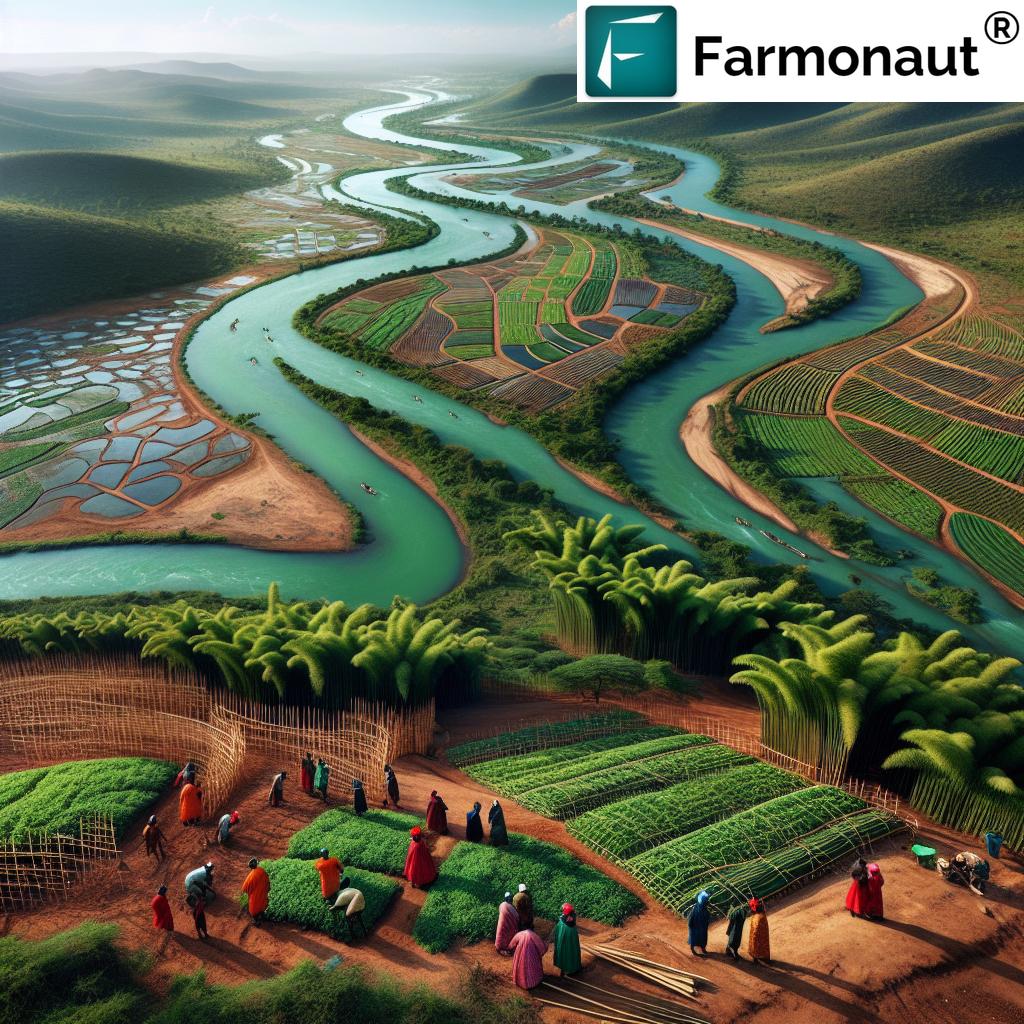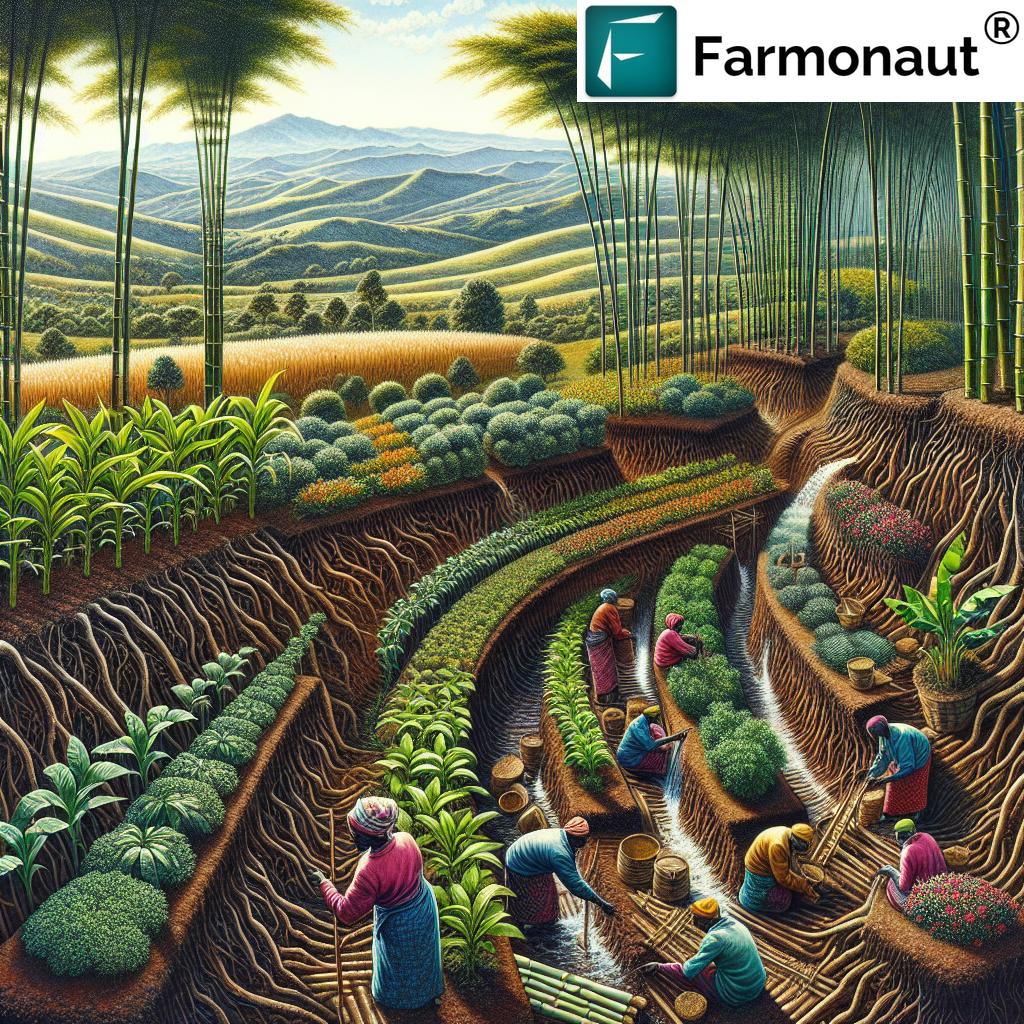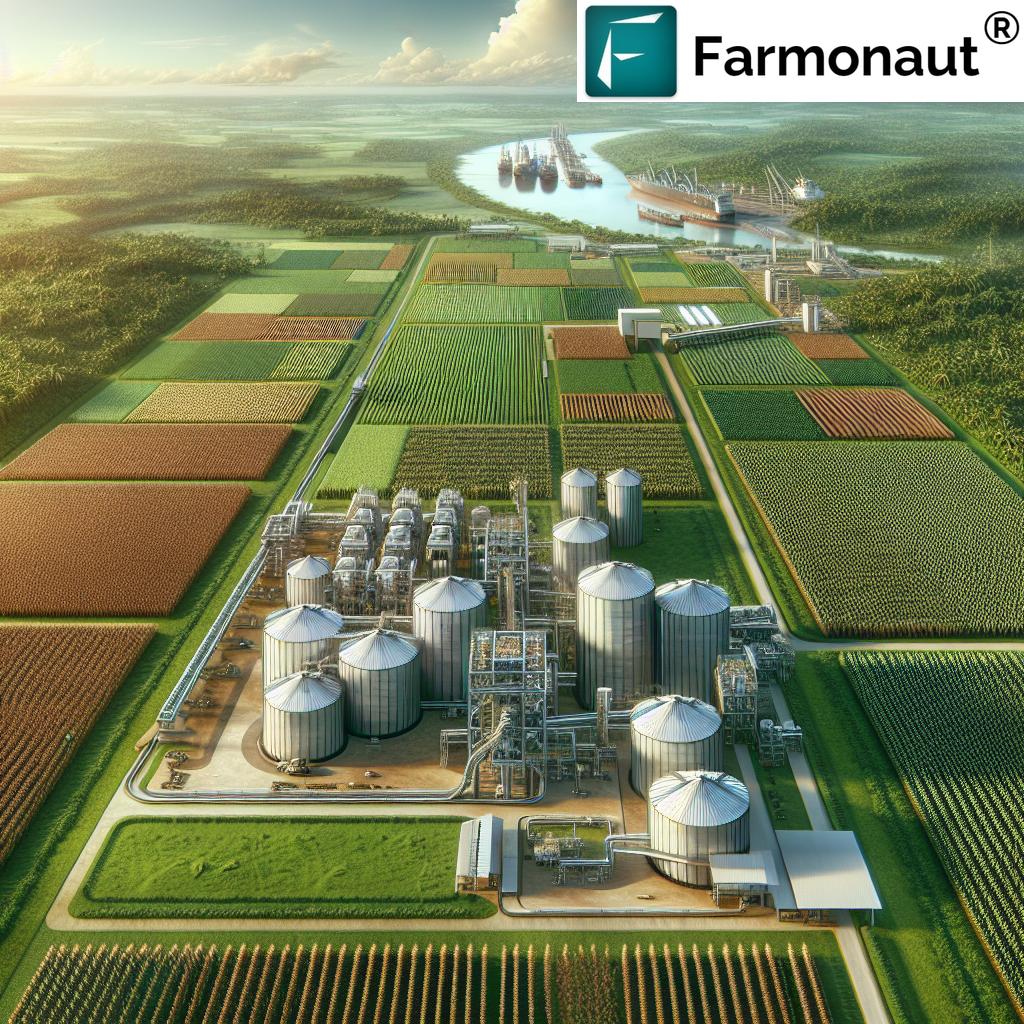Bamboo Agroforestry: Transforming Kenya’s Nzoia River Basin with Climate-Smart Solutions for Flood Resilience
“Bamboo agroforestry in Kenya’s Nzoia River basin protects against flooding while enabling cultivation of 3+ diverse crops.”
In the heart of western Kenya, along the banks of the Nzoia River, a remarkable transformation is taking place. We are witnessing the power of bamboo agroforestry in revolutionizing flood prevention and sustainable agriculture. This innovative approach is not just addressing the pressing challenges of climate change; it’s reshaping the landscape and livelihoods of smallholder farmers in the region.
As we delve into this exciting initiative, we’ll explore how bamboo farming is becoming a game-changer for flood resilience, ecosystem restoration, and climate-smart agriculture practices. Join us on this journey through Kenya’s Nzoia River basin, where nature-based solutions are taking root and flourishing.
The Genesis of Bamboo Agroforestry in Kenya
For decades, farmers in the Nzoia River basin have grappled with the devastating effects of seasonal flooding. The recurring inundations not only destroyed crops but also eroded precious topsoil, leaving behind degraded farmland. However, a beacon of hope emerged four years ago when an innovative bamboo agroforestry initiative was introduced.
This project, funded by the Chinese Academy of Sciences through the Sino-Africa Joint Research Center and implemented by the United Nations Environment Programme’s International Ecosystem Management Partnership, aims to provide a sustainable solution to these environmental challenges.

The Power of Bamboo: Nature’s Flood Defense
Bamboo, with its unique properties, has emerged as a formidable ally in the fight against flooding. Here’s why bamboo is proving to be an excellent choice for agroforestry in flood-prone areas:
- Rapid Growth: Bamboo grows incredibly fast, establishing a strong root system quickly.
- Soil Stabilization: The extensive root network of bamboo helps prevent soil erosion along riverbanks.
- Water Absorption: Bamboo plants can absorb large quantities of water, reducing flood risks.
- Resilience: These plants can withstand flooding and recover rapidly after inundation.
By integrating bamboo into their farming practices, smallholder farmers are not just protecting their land; they’re revolutionizing their approach to agriculture in the face of climate change.
Training and Technology Transfer
At the heart of this initiative is a comprehensive training program that equips farmers with the knowledge and skills needed to cultivate bamboo effectively. The project focuses on:
- Bamboo cultivation techniques
- Establishment of nurseries
- Proper planting methods along riverbanks
- Integration of bamboo with traditional food crops
This transfer of technology and knowledge is crucial in ensuring the long-term success and sustainability of the project. By empowering local farmers, the initiative is building resilience from the ground up.
Beyond Flood Prevention: The Multifaceted Benefits of Bamboo Agroforestry
While flood prevention is a primary goal, the benefits of bamboo agroforestry extend far beyond this. Let’s explore the wide-ranging impacts of this innovative approach:
Soil Rejuvenation
Bamboo plants have a remarkable ability to improve soil quality. Their extensive root systems help:
- Prevent soil erosion
- Increase organic matter content
- Enhance soil structure and fertility
As a result, farmers are witnessing a transformation in their once-degraded lands, now capable of supporting a diverse range of crops.
Crop Diversification
With improved soil conditions, farmers can now cultivate a variety of crops alongside bamboo, including:
- Maize
- Legumes
- Bananas
- Millet
This diversification not only enhances food security but also provides additional income streams for smallholder farmers.
Economic Opportunities
Bamboo isn’t just a protective measure; it’s also a valuable resource. Farmers are discovering new income opportunities through:
- Selling bamboo for furniture production
- Creating compost from bamboo leaves
- Developing bamboo-based handicrafts
These economic benefits are crucial in improving the livelihoods of local communities.
“Women in Kenya’s Nzoia River basin gain new income opportunities through traditional bamboo weaving and product creation.”
Environmental Conservation
Bamboo agroforestry is playing a significant role in environmental conservation:
- Acting as a carbon sink, absorbing CO2 from the atmosphere
- Promoting biodiversity by creating habitats for various species
- Reducing pressure on natural forests for timber and fuel
This holistic approach to farming is helping to restore and protect the delicate ecosystem of the Nzoia River basin.

Empowering Women Through Agricultural Innovation
One of the most inspiring aspects of this bamboo agroforestry initiative is its impact on women in the community. Through this project, women are finding new avenues for economic empowerment:
- Traditional weaving using bamboo fibers
- Creating and selling bamboo-based products
- Participating in nursery management and seedling production
These opportunities are not just providing additional income; they’re also elevating the role of women in agricultural innovation and community development.
The Role of Technology in Bamboo Agroforestry
While traditional knowledge plays a crucial role in this initiative, modern technology is equally important in maximizing its impact. At Farmonaut, we understand the power of technology in transforming agriculture. Our satellite-based farm management solutions can provide valuable insights for bamboo agroforestry projects:
- Monitoring vegetation health through NDVI (Normalized Difference Vegetation Index)
- Tracking soil moisture levels
- Providing real-time weather forecasts
These technological tools can help farmers make informed decisions about planting, irrigation, and resource management, further enhancing the effectiveness of bamboo agroforestry.
Learn more about our satellite-based solutions: Farmonaut Satellite API
Scaling Up: The Future of Bamboo Agroforestry in Kenya
The success of the bamboo agroforestry initiative in the Nzoia River basin has sparked interest in scaling up the project. Future plans include:
- Expanding the training program to reach over 200 farmers
- Establishing demonstration sites to showcase effective ecological restoration techniques
- Developing large-scale bamboo plantations for multiple uses
As the project grows, it has the potential to transform not just the Nzoia River basin, but other flood-prone regions across Kenya and beyond.
Comparative Analysis: Traditional Farming vs. Bamboo Agroforestry
To fully appreciate the impact of bamboo agroforestry, let’s compare it with traditional farming practices in the Nzoia River basin:
| Aspect | Traditional Farming | Bamboo Agroforestry | Benefits of Bamboo Agroforestry |
|---|---|---|---|
| Flood Resilience | Low | High | Reduced flood damage, improved river bank stability |
| Soil Quality | Prone to erosion | Enhanced soil structure | Improved fertility, reduced soil loss |
| Crop Diversity | Limited | High | Increased food security, varied income sources |
| Income Opportunities | Seasonal, crop-dependent | Year-round, diversified | Stable income, new market opportunities |
| Environmental Impact | Potentially negative | Positive | Carbon sequestration, biodiversity enhancement |
This comparison clearly illustrates the transformative potential of bamboo agroforestry in addressing the challenges faced by farmers in the Nzoia River basin.
The Global Context: Bamboo Agroforestry and Climate Change
The bamboo agroforestry initiative in Kenya’s Nzoia River basin is not just a local success story; it’s part of a global movement towards nature-based solutions for climate change. Here’s how this project aligns with broader environmental goals:
- Carbon Sequestration: Bamboo is known for its exceptional ability to absorb carbon dioxide, making it an effective tool in the fight against climate change.
- Sustainable Development Goals: The project contributes to several UN Sustainable Development Goals, including Climate Action, Zero Hunger, and Life on Land.
- Biodiversity Conservation: By creating diverse ecosystems, bamboo agroforestry supports a wide range of flora and fauna.
As we face global environmental challenges, initiatives like this serve as beacons of hope and models for sustainable agriculture worldwide.
The Role of Artificial Intelligence in Advancing Bamboo Agroforestry
As we look to the future of bamboo agroforestry, artificial intelligence (AI) is set to play a crucial role in optimizing these systems. At Farmonaut, we’re at the forefront of integrating AI into agricultural practices. Here’s how AI can enhance bamboo agroforestry:
- Predictive Analytics: AI algorithms can analyze historical data to predict flood patterns and optimize bamboo planting strategies.
- Crop Health Monitoring: Machine learning models can process satellite imagery to detect early signs of plant stress or disease in bamboo plantations.
- Resource Optimization: AI can help farmers make data-driven decisions about water usage, fertilizer application, and harvest timing.
By leveraging AI technologies, we can further enhance the effectiveness and efficiency of bamboo agroforestry systems.
Explore our AI-driven agricultural solutions: Farmonaut API Developer Docs
Frequently Asked Questions (FAQ)
As we conclude our exploration of bamboo agroforestry in Kenya’s Nzoia River basin, let’s address some common questions:
- Q: How long does it take for bamboo to establish and provide flood protection?
A: Bamboo grows rapidly, with significant root development within the first year. However, full flood protection benefits are typically realized after 2-3 years of growth. - Q: Can bamboo agroforestry be implemented in other regions?
A: Yes, bamboo agroforestry can be adapted to various climates and soil types, making it a versatile solution for many flood-prone regions worldwide. - Q: How does bamboo agroforestry impact local wildlife?
A: Bamboo plantations create diverse habitats that support a wide range of wildlife, including birds, insects, and small mammals, enhancing local biodiversity. - Q: Are there any potential drawbacks to bamboo agroforestry?
A: While generally beneficial, improper management of bamboo can lead to invasive spread. Proper training and species selection are crucial to prevent this issue. - Q: How can farmers get involved in bamboo agroforestry initiatives?
A: Farmers can reach out to local agricultural extension offices or environmental NGOs for information on training programs and support for implementing bamboo agroforestry.
Conclusion: A Green Revolution in Flood Resilience
The bamboo agroforestry initiative in Kenya’s Nzoia River basin stands as a testament to the power of nature-based solutions in addressing complex environmental challenges. By harnessing the unique properties of bamboo, this project is not only mitigating flood risks but also transforming livelihoods, enhancing food security, and contributing to global climate change mitigation efforts.
As we look to the future, the potential for scaling up and replicating this model in other regions is immense. With the integration of advanced technologies like satellite monitoring and AI, bamboo agroforestry is poised to play an even more significant role in shaping sustainable agricultural practices worldwide.
At Farmonaut, we’re committed to supporting innovative agricultural solutions like bamboo agroforestry through our advanced satellite-based farm management tools. Together, we can build a more resilient, sustainable future for agriculture in the face of climate change.
Ready to revolutionize your farming practices? Explore Farmonaut’s solutions:
















